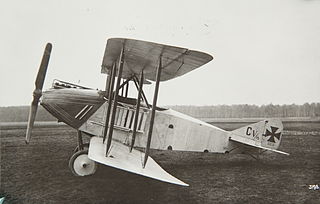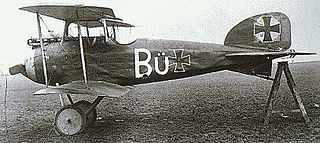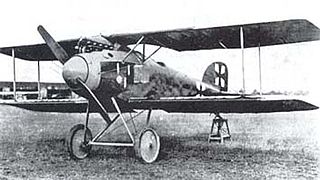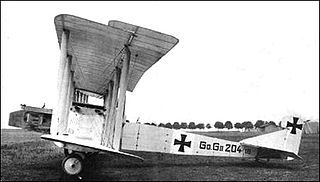
The AEG C.III was a two-seat biplane reconnaissance aircraft, a single prototype of which was built during World War I. The aircraft featured an unusual fuselage design that completely filled the gap between the upper and lower sets of wings, to provide the pilot with improved vision, and to allow the observer a wider field of fire for his 7.92 mm (.312 in) machine gun. The pilot sat to the rear of the observer, who was stationed over the upper wing. This design was not as successful as had been hoped, and the C.III was never entered into service. Despite being heavier than the C.II, its maximum speed increased to 158 km/h (98 mph).

The AEG C.V was a prototype two-seat biplane reconnaissance aircraft of World War I. Designed to use a more powerful engine than previous AEG C-class reconnaissance aircraft, results were disappointing enough that further development was cancelled.
The AEG C.VI was a prototype two-seat biplane reconnaissance aircraft of World War I. It was developed in 1916 from the AEG C.IV, but did not enter production.

The AEG C.VII was a prototype two-seat biplane reconnaissance aircraft of World War I. It was developed from the C.IV but did not enter production. The C.VII was tested with two different wing arrangements, one with slightly tapered single bay wings and another with sharply swept upper wing.

The AEG C.VIII was a prototype two-seat reconnaissance aircraft of World War I. Two examples were built, based on the successful C.IV design, one of biplane configuration, the other a triplane. Neither version offered enough of an improvement on the C.IV to make mass production worthwhile.

The AEG D.I was a biplane fighter of World War I. Three prototypes were ordered, but after the first two were involved in serious crashes, one of which killed flying ace Walter Höhndorf on September 5, 1917, development was cancelled. A triplane version was built as the Dr.I. The second and third prototypes differed little from the first except in detail.
The AEG DJ.I was a highly streamlined biplane ground attack aircraft of late World War I that was undergoing evaluation at the time of the Armistice.

The AEG G.I was a three-seat, twin-engined German biplane bomber aircraft of World War I. It was tested and found to be viable for air-fighting in the latter half of 1915 but performed poorly, necessitating the development of the AEG G.II.

The AEG G.II was a German biplane bomber aircraft of World War I developed from the AEG G.I, with more powerful engines. The G.II was typically armed with three 7.92 mm (.312 in) machine guns and 200 kg (440 lb) of bombs. The bomber suffered stability problems, and many G.IIs were fitted with additional vertical tail surfaces on each side of the fin and rudder to improve flight handling characteristics.

The AEG G.V was a biplane bomber aircraft of World War I, a further refinement of the AEG G.IV. The type saw limited production before the Armistice, and never entered operational service. It featured a 600 kg (1,320 lb) bombload.

The AEG PE was a triplane ground-attack aircraft of World War I, one of the first aircraft designed from the outset for that role. The Idflieg rejected it on the grounds that its poor maneuverability made it too vulnerable to enemy fighters.

The Albatros D.I was a German fighter aircraft used during World War I. Although its operational career was short, it was the first of the Albatros D types which equipped the bulk of the German and Austrian fighter squadrons (Jagdstaffeln) for the last two years of the war.

The Albatros D.II was a German fighter aircraft used during World War I. After a successful combat career in the early Jagdstaffeln, it was gradually superseded by the Albatros D.III.

The Gotha G.II series was a heavy bomber used by the Luftstreitkräfte during World War I.

The Fokker D.V was a German biplane fighter of World War I.

The Pfalz Dr.I was a German fighter prototype of World War I. Official interest in the potential of the triplane configuration for single-seat fighters prompted Pfalz to develop the Dr.I. It underwent initial testing in October 1917, and an initial batch of 10 aircraft were shipped to the Front and arrived in April 1918.

The Austin A.F.T.3 Osprey was a prototype British fighter triplane of the First World War. Developed by the motor car manufacturer Austin as a replacement to the Sopwith Camel, only one was built, the Sopwith Snipe being preferred.

The Zeppelin-Lindau CS.I was a German single-engined reconnaissance seaplane with a low-wing monoplane layout.

The Halberstadt G.I was a German prototype heavy bomber built by Halberstädter Flugzeugwerke during World War I.
The Pfalz Dr.II was a German triplane fighter prototype of World War I built by Pfalz Flugzeugwerke.

















